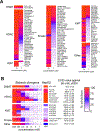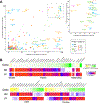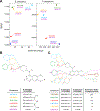Activity Comparison of Epigenetic Modulators against the Hemoprotozoan Parasites Babesia divergens and Plasmodium falciparum
- PMID: 33599488
- PMCID: PMC9022219
- DOI: 10.1021/acsinfecdis.0c00853
Activity Comparison of Epigenetic Modulators against the Hemoprotozoan Parasites Babesia divergens and Plasmodium falciparum
Abstract
Babesiosis is a tick-borne parasitic disease of humans and livestock that has dramatically increased in frequency and geographical range over the past few decades. Infection of cattle often causes large economic losses, and human infection can be fatal in immunocompromised patients. Unlike for malaria, another disease caused by hemoprotozoan parasites, limited treatment options exist for Babesia infections. As epigenetic regulation is a promising target for new antiparasitic drugs, we screened 324 epigenetic inhibitors against Babesia divergens blood stages and identified 75 (23%) and 17 (5%) compounds that displayed ≥90% inhibition at 10 and 1 μM, respectively, including over a dozen compounds with activity in the low nanomolar range. We observed differential activity of some inhibitor classes against Babesia divergens and Plasmodium falciparum parasites and identified pairs of compounds with a high difference in activity despite a high similarity in chemical structure, highlighting new insights into the development of epigenetic inhibitors as antiparasitic drugs.
Keywords: Babesia; Plasmodium; epigenetic; parasites; small molecule screen.
Conflict of interest statement
The authors declare no competing financial interest.
Figures





Similar articles
-
Inhibition of malaria and babesiosis parasites by putative red blood cell targeting small molecules.Front Cell Infect Microbiol. 2024 Mar 20;14:1304839. doi: 10.3389/fcimb.2024.1304839. eCollection 2024. Front Cell Infect Microbiol. 2024. PMID: 38572319 Free PMC article.
-
[Laboratory diagnostic of human babesiosis.].Klin Lab Diagn. 2019;64(9):560-564. doi: 10.18821/0869-2084-2019-64-9-560-564. Klin Lab Diagn. 2019. PMID: 31610109 Russian.
-
Four-Dimensional Characterization of the Babesia divergens Asexual Life Cycle, from the Trophozoite to the Multiparasite Stage.mSphere. 2020 Oct 14;5(5):e00928-20. doi: 10.1128/mSphere.00928-20. mSphere. 2020. PMID: 33055261 Free PMC article.
-
Unravelling the cellular and molecular pathogenesis of bovine babesiosis: is the sky the limit?Int J Parasitol. 2019 Feb;49(2):183-197. doi: 10.1016/j.ijpara.2018.11.002. Epub 2019 Jan 26. Int J Parasitol. 2019. PMID: 30690089 Free PMC article. Review.
-
[Babesiosis, a little known zoonosis].Epidemiol Mikrobiol Imunol. 2007 Nov;56(4):176-80. Epidemiol Mikrobiol Imunol. 2007. PMID: 18072299 Review. Czech.
Cited by
-
Evaluating Antimalarial Proteasome Inhibitors for Efficacy in Babesia Blood Stage Cultures.ACS Omega. 2024 Oct 28;9(45):44989-44999. doi: 10.1021/acsomega.4c04564. eCollection 2024 Nov 12. ACS Omega. 2024. PMID: 39554424 Free PMC article.
-
Characterization of anti-erythrocyte and anti-platelet antibodies in hemolytic anemia and thrombocytopenia induced by Plasmodium spp. and Babesiaspp. infection in mice.Front Cell Infect Microbiol. 2023 Apr 14;13:1143138. doi: 10.3389/fcimb.2023.1143138. eCollection 2023. Front Cell Infect Microbiol. 2023. PMID: 37124034 Free PMC article.
-
A propidium iodide-based in vitro screen of the "Bug Box" against Babesia duncani reveals potent inhibitors.Antimicrob Agents Chemother. 2025 Jul 2;69(7):e0003525. doi: 10.1128/aac.00035-25. Epub 2025 Jun 9. Antimicrob Agents Chemother. 2025. PMID: 40488628 Free PMC article.
-
Virtual Special Issue: Epigenetics 2022.ACS Med Chem Lett. 2022 Oct 13;13(10):1524-1529. doi: 10.1021/acsmedchemlett.2c00393. eCollection 2022 Oct 13. ACS Med Chem Lett. 2022. PMID: 36262399 Free PMC article. No abstract available.
-
Virtual Special Issue: Epigenetics 2022.ACS Pharmacol Transl Sci. 2022 Sep 9;5(10):829-834. doi: 10.1021/acsptsci.2c00169. eCollection 2022 Oct 14. ACS Pharmacol Transl Sci. 2022. PMID: 36268124 Free PMC article. No abstract available.
References
-
- Gray EB, and Herwaldt BL (2019) Babesiosis Surveillance — United States, 2011–2015. MMWR Surveill Summ 68, 1–11. - PubMed
-
- Hildebrandt A, Gray JS, and Hunfeld KP (2013) Human Babesiosis in Europe: what clinicians need to know. Infection 41, 1057–1072. - PubMed
-
- Krause PJ (2019) Human babesiosis. Int. J. Parasitol 49, 165–174. - PubMed
-
- US Federal Drug Administration, Center for Biologics Evaluation and Research. (2019) Recommendations for Reducing the Risk of Transfusion-Transmitted Babesiosis Guidance for Industry. https://www.fda.gov/regulatory-information/search-fdaguidance-documents/....
Publication types
MeSH terms
Grants and funding
LinkOut - more resources
Full Text Sources
Other Literature Sources
Research Materials
Miscellaneous

